Security Roles
Every user who would like to have access to use PowerCharge will need the PowerCharge User assigned to them. For users who would like to have the ability to create transactions on behalf of other users need the PowerCharge Administrator security role. System Administrators will automatically see PowerCharge in their left navigation and be able to use PowerCharge, even without having the security role assigned.
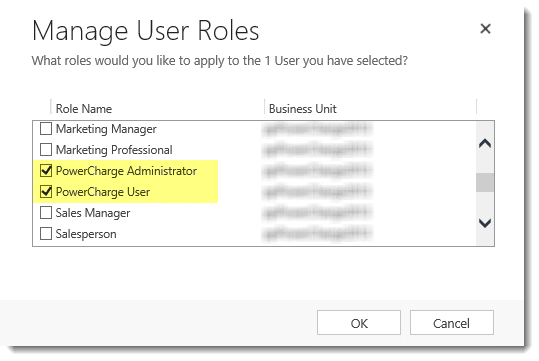
Configuring PowerCharge
Once you have imported and registered the PowerCharge solution for your Microsoft Dynamics CRM system it will need to be configured. To configure PowerCharge navigate to the setup tab. Once you’ve clicked on the Setup Tab, you can choose a debug mode. By default, the “Minimum” debug mode will be turned on. This will include logs for important events, such as errors in the PowerCharge log. The Advanced debug mode will create additional debug records which may be useful in debugging. However, the Advanced method of debugging may take up more disk space and is not recommended. Next, choose your default gateway. This is the gateway that will be used, by default when you store new credit card records.
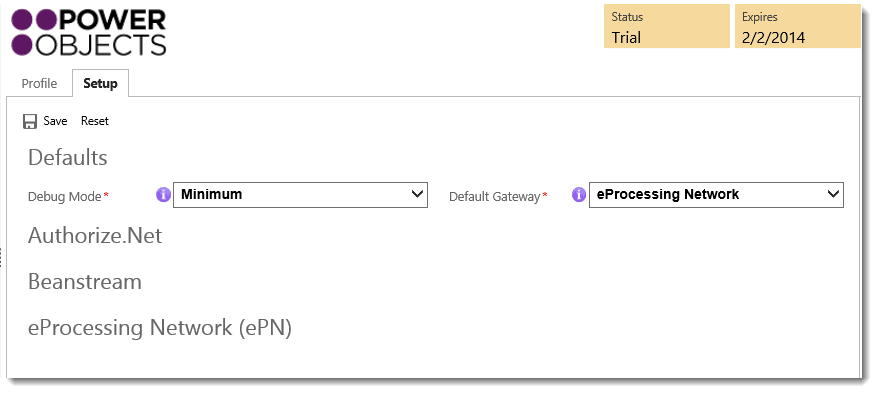
After you determine your defaults, click on the name of the gateway you would like to use. Enter the required information and Save. The required information can be found by logging into your payment gateway.
For more information on how you to set up your payment gateway, see the Gateway Configuration section below.
Note: You will need a merchant account with authorize.net, BeanStream or eProcessing Network in order for PowerCharge to work in your CRM system. If you do not already have one of these merchant accounts, please contact:
Nikki Norton
Business Consultant
Nikki@NortonBusinessSolutions.com
Direct: 612.803.1855
Gateway Configuration
This document will outline the steps in configuring the processing gateways that can be used with PowerObjects’ PowerCharge add-on.
eProcessing Network's Configuration
To configure eProcessing Network (ePN) in PowerCharge you will need an Account ID, Password, and Restrict Key. The Account ID and Password will be equivalent to the Username and Password you use to log in to ePN Merchant Support Center below.
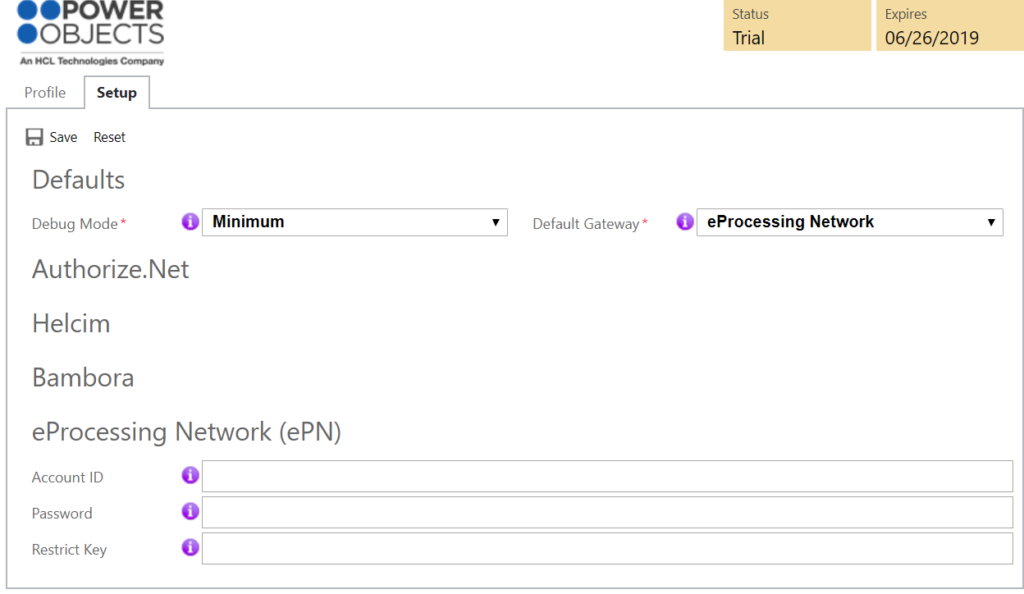
- Login to the eProcessing Network Merchant Support Center with your user ID and password: https://www.eprocessingnetwork.com/msclogin.html
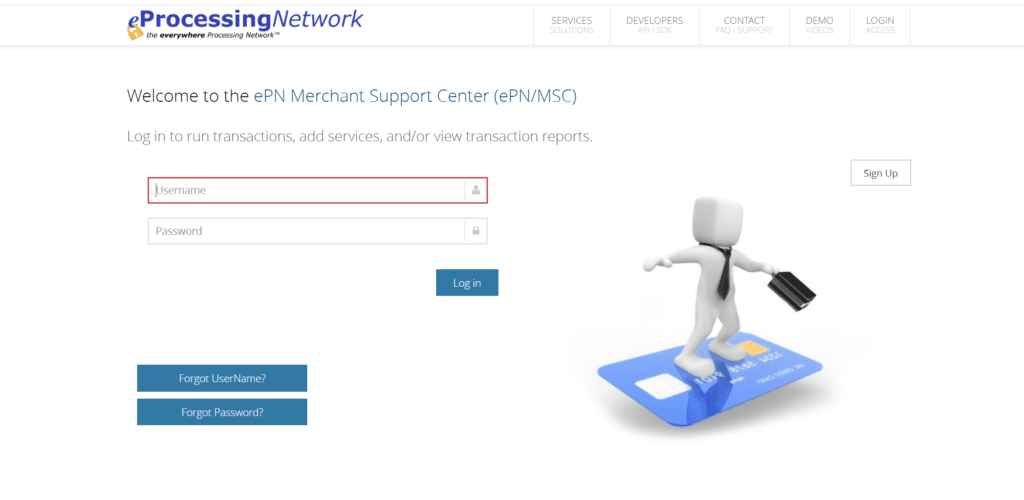
- Select ‘Web Services’ in the side menu, and then ‘Processing Controls’.
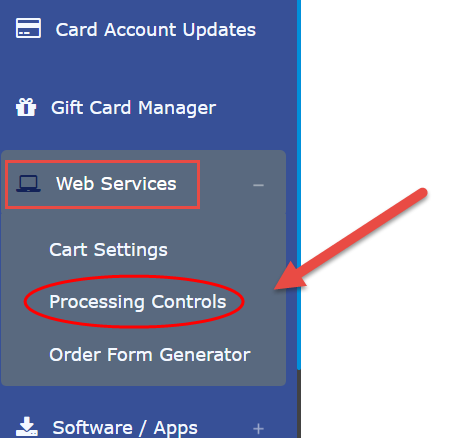
- Verify that the box for TDBE is not selected. If this box is checked, attempts to communicate with ePN will return as ‘UBlocked’.

- In the same section, scroll down and verify that the box to allow use of the Restrict Key is checked. You can copy and paste the Restrict Key into your PowerCharge configuration.
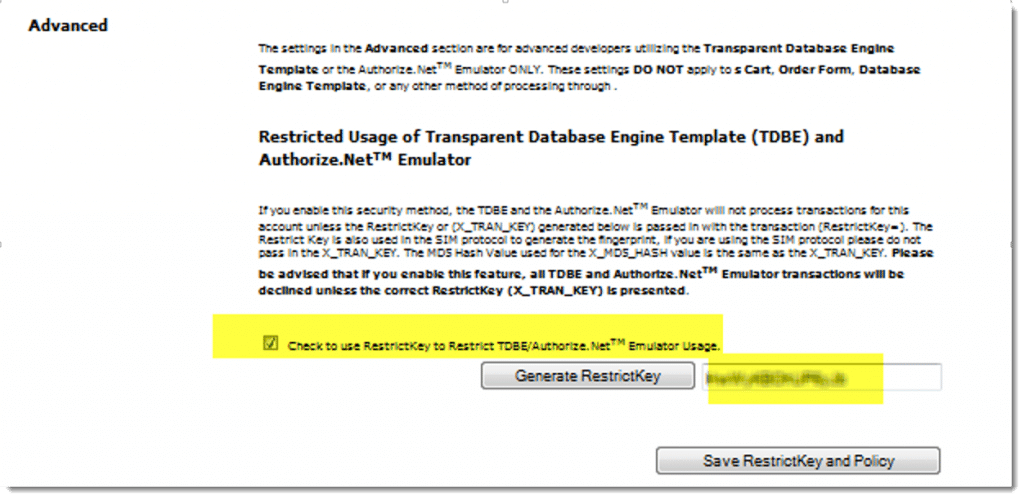
- If you wish to allow ePN to process return (refund) transactions, check the box next to the option named, “Allow return/credit transactions” and click the “Save Return Transaction Policy” button.

- Scroll down to the ‘pre-processing’ section and set both Transaction Attempts to 100 and 5. Then click the “Update Attempts,” button.

Please note that ePN uses batching with its transactions. Refunds may not go through on an order while a transaction is processing. To view your Current Batch Report, go to the ePN Merchant Support Center and click on “Activity Reports” in the side menu. Then click on “Current Batch Report”. This will list all the transaction that have not been closed and are prepared in a ‘batch’ which will process each day at a standard time. If you wish to process and close these transactions immediately click on the “Close>>” button.
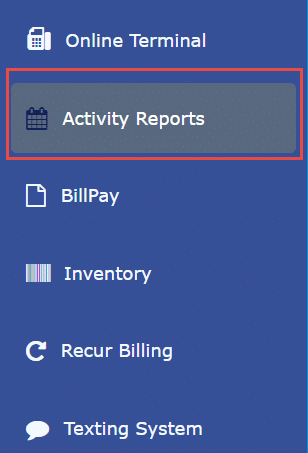

Bambora Configuration
To configure Bambora in PowerCharge you will need a Merchant ID, API Username, API Password, and API Passcode.
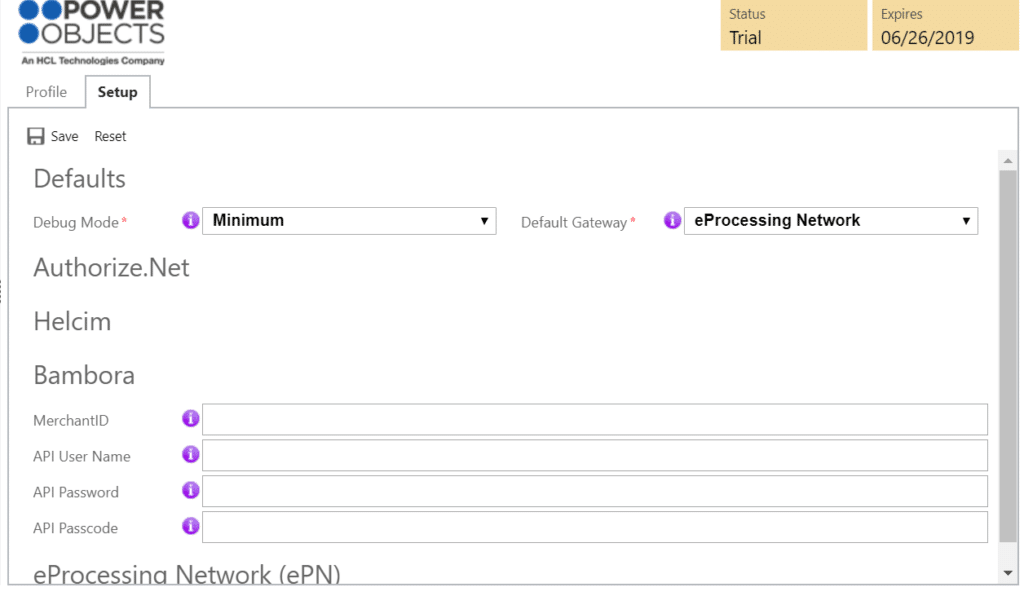
- In a browser navigate to https://web.na.bambora.com/admin/sDefault.asp
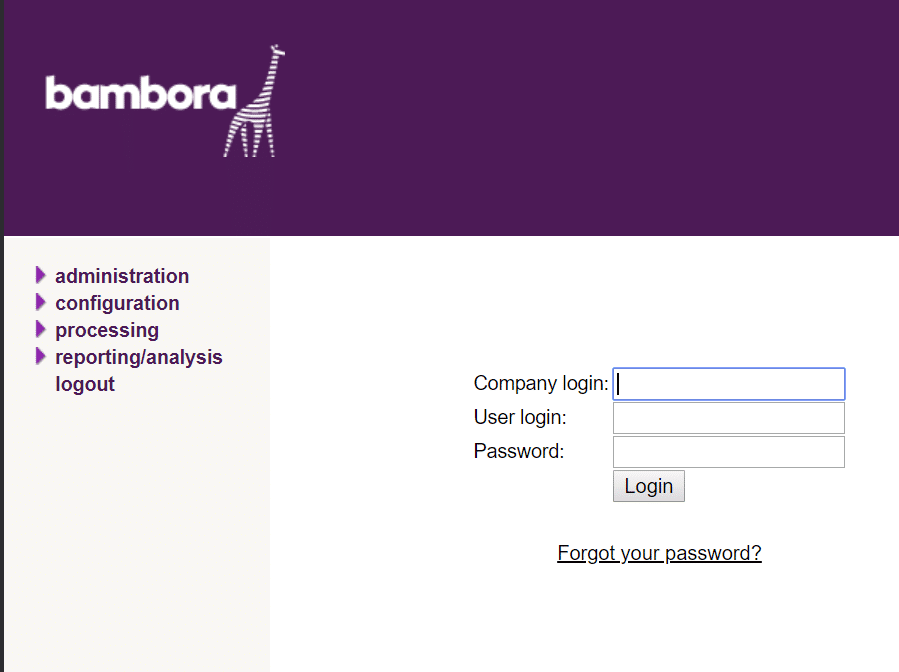
- Log in to the Bambora Merchant Portal
- You can find your Merchant ID at any time in the Merchant Portal at the top right of your screen.

- In the side menu select ‘Administration’, then ‘Account Settings’ and finally ‘Order Settings’.
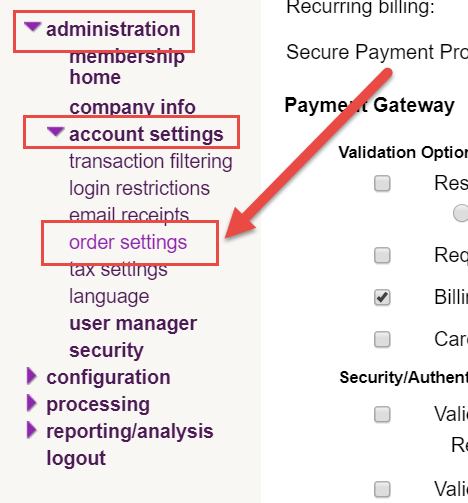
- Under the ‘Payment Gateway’ section, navigate to the ‘Validation Options’ section, and uncheck ‘Restrict Internet Transaction Processing Types’. Note: leaving this option checked with the ‘Purchase only’ radio button selected will allow PowerCharge to process charges, but will block all refund transaction attempts.
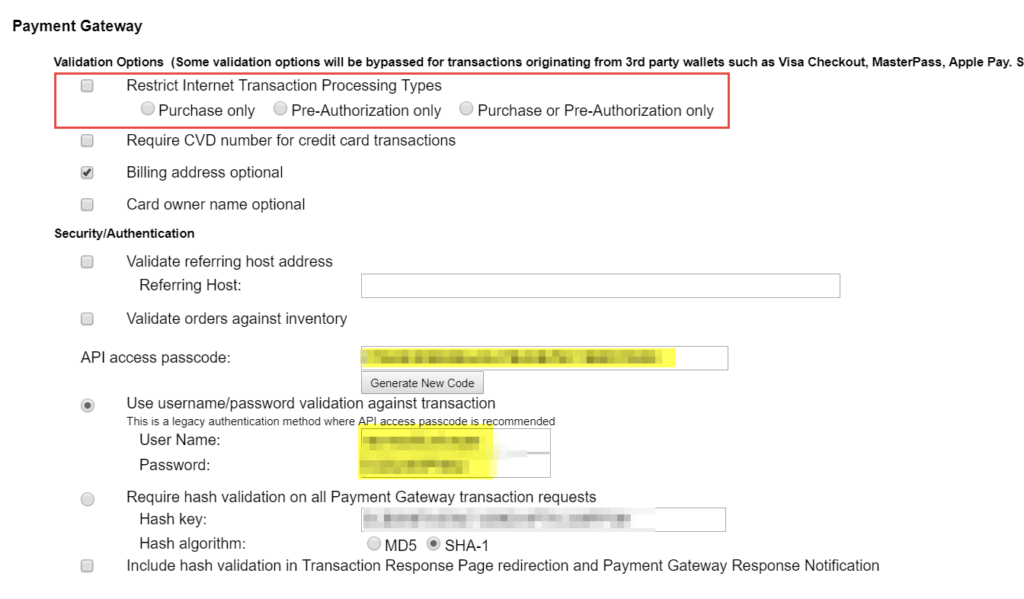
- Scroll down and you will find the ‘API access passcode’ settings, and click on the ‘Generate New Code’ button. You can copy the generated string, and paste it into the API Passcode field in the PowerCharge Configuration pane.
- Select the ‘Use username/password validation against transaction’ radio button, and enter a ‘User Name’ and ‘Password’ you would like to use into the appropriate fields (these cannot be the same User Name and Password you use to log in to the Bambora Merchant Portal). In the PowerCharge Configuration pane, enter the same User Name into the API User Name field and the same Password into the API Password
- Scroll to the bottom of the page and locate the ‘Update’ button, and click it to save these changes.
If you have any trouble finding this information, please contact your merchant account representative.
Authorize.net Configuration
Before your Start
Verify that the Customer Information Manager (CIM) has been enabled on your Authorize.Net account. Failure to activate CIM will result in the following error message when attempting to tokenize credit cards with PowerCharge:
“E00044 Customer Information Manager in not enabled”
A full list of error codes and requirements can be found in the documentation publicly available on Authorize.net’s CIM webpage: http://developer.authorize.net/api/cim/
To configure Authorize.Net in PowerCharge you will need an API Login, and Transaction Key. To process real credit cards (instead of test cards), set Mode to “Live”.
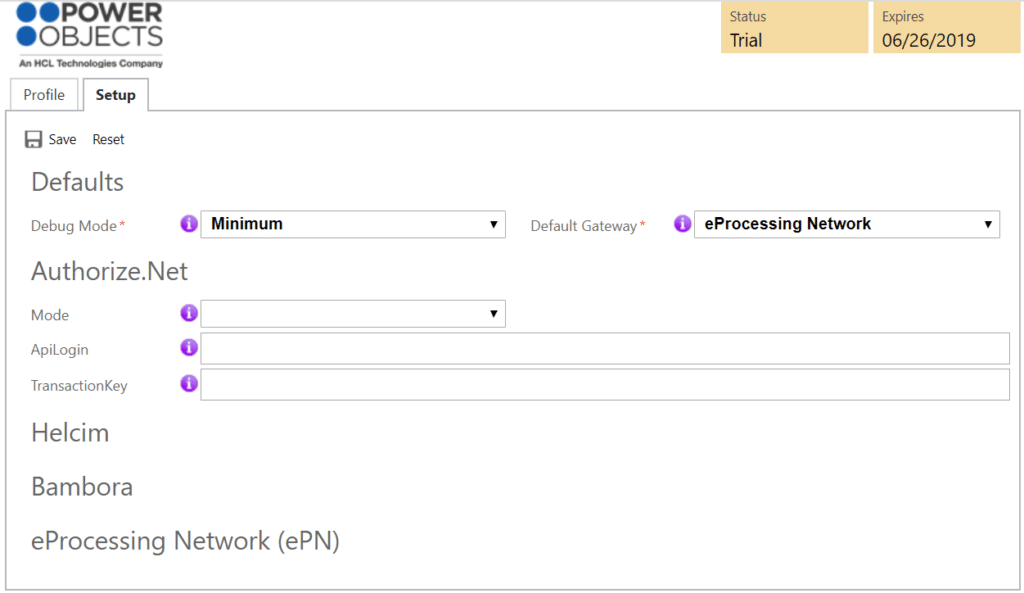
- Log in to Authorize.Net at https://account.authorize.net/
- Select along the top menu ‘Account’. Then, on the side menu, select ‘Settings’. Finally, select ‘API Credentials & Keys’.
- Here you will find the API Login ID, which you can copy and paste to the API Login field in the PowerCharge Configuration Pane.
- To get a new Transaction Key, you will have to select the ‘New Transaction Key’ radio button, and answer the secret question. A string will be provided that you can copy and paste into the Transaction Key field in the PowerCharge Configuration pane.
- If you are using an Authorize.net Sandbox account you will need to change the value of the Authorize.net Mode setting. Select ‘Account’ from the top menu, and ‘Settings’ from the side menu.
- Use the slider to select ‘Live’ mode.
Note: Sandbox and Live modes use different authentication credentials. Failure to use the correct API Login and Transaction Key with the appropriate Authorize.net mode will result in error code: E00007 when attempting to save a credit card in PowerCharge.
Other Notable Features with Authorize.Net:
- PowerCharge supports refunds with Authorize.net. However, Authorize.net settles transactions as a batch only once per day, so attempts to refund against a transaction that has not yet been settled will result in the error: “E00027 – The referenced transaction does not meet the criteria for issuing a credit”. Batch transaction settlements can take 24-30 hours depending on the time of transaction and settlement workload of the Authorize.net system.
- For security reasons, once a credit card is tokenized with Authorize.net, any changes to the values on a CRM record will not be reflected in the CIM interface unless the credit card number and CCV are re-entered on the CRM record at the time the other values are updated.
- Deleting a credit card record in CRM will result in the deletion of the corresponding payment profile in Authorize.net’s CIM interface. Any remaining PowerCharge transaction records will stay in CRM.
- By default, Authorize.net will send a transaction receipt to the email address listed on the PowerCharge credit card form. This can be disabled in the Account > Settings > Email Receipt section of the Authorize.net administration area.
- The email address, Parent Account and Contact will be listed in the Payment Profile along with the name on the credit card. This allows for easy searching within the CIM interface.
Helcim Configuration
To configure Helcim in PowerCharge you will need an Account ID, and API Token. To process real credit cards (instead of test cards), set Mode to “Live”.
Helcim has two portals you can use, Helcim Virtual Terminal and Helcim Commerce. You can choose which version you would like to use, by selecting one from the Gateway Version selector in the configuration screen.
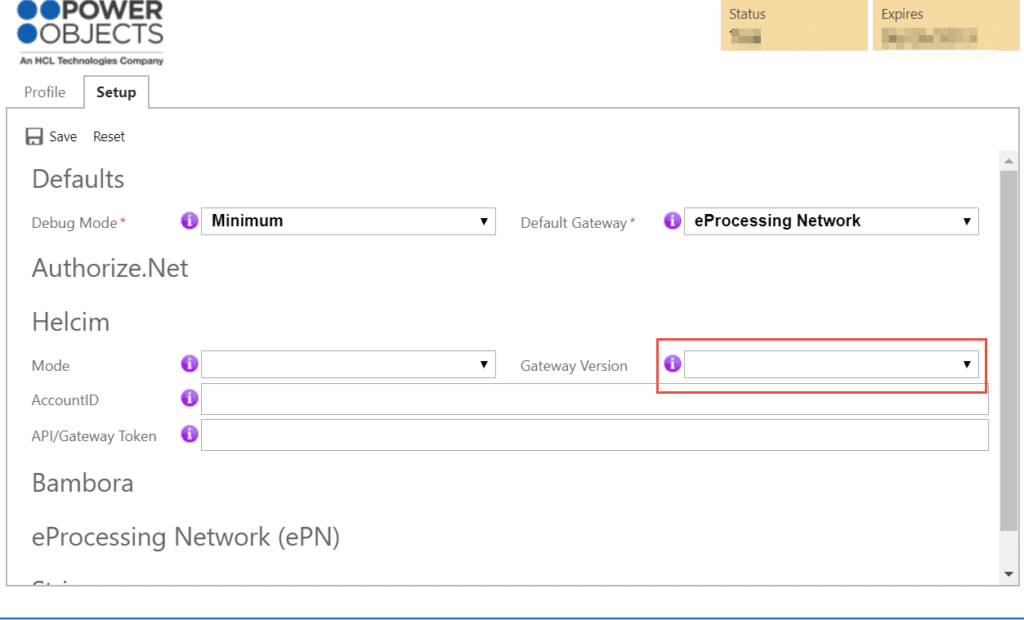
Helcim Commerce
- Log in to Helcim Commerce at https://admin.helcim.com/login/
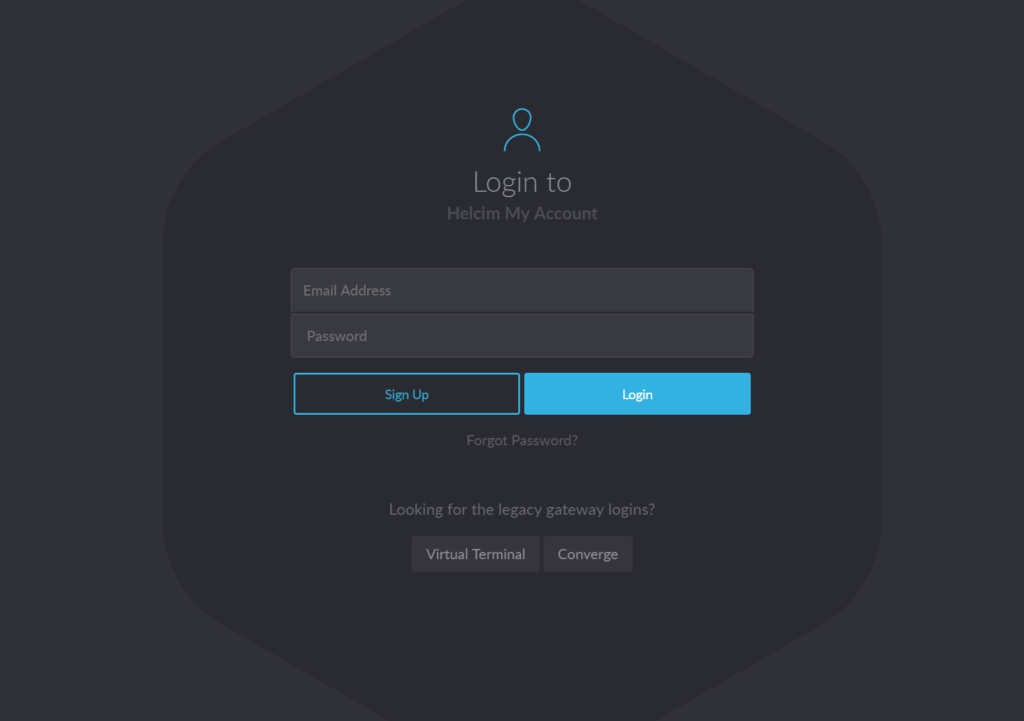
- On the side menu, click on ‘Heclim Commerce’.
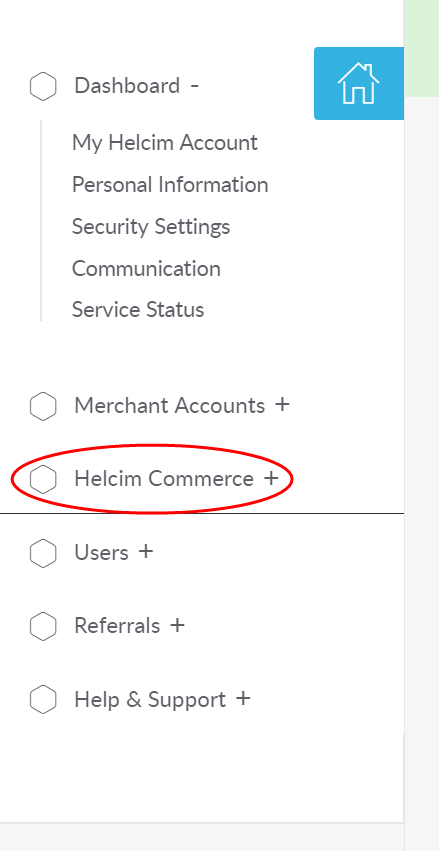
- Copy the Commerce Account ID, and paste it into the Account ID field in the PowerCharge Configuration pane.

- Click on the ‘Commerce URL’ link. Your Account Information will be shown. Click on the ‘Login to Helcim Commerce’ button.

- Scroll down and click on the ‘Integrations’ button.
- Click on the ‘API Access’ button.

- Copy the ‘Token’ and paste into the API/Gateway Token field the PowerCharge Configuration pane. If no Token is available, you can generate a new one by clicking on the ‘New API Access’ button.

- To create a ‘New API Access’, enter a nickname for your user, and select the appropriate ‘Access Restrictions’ for that user. Click on ‘Save’ to create API Access User, and follow Step 7.
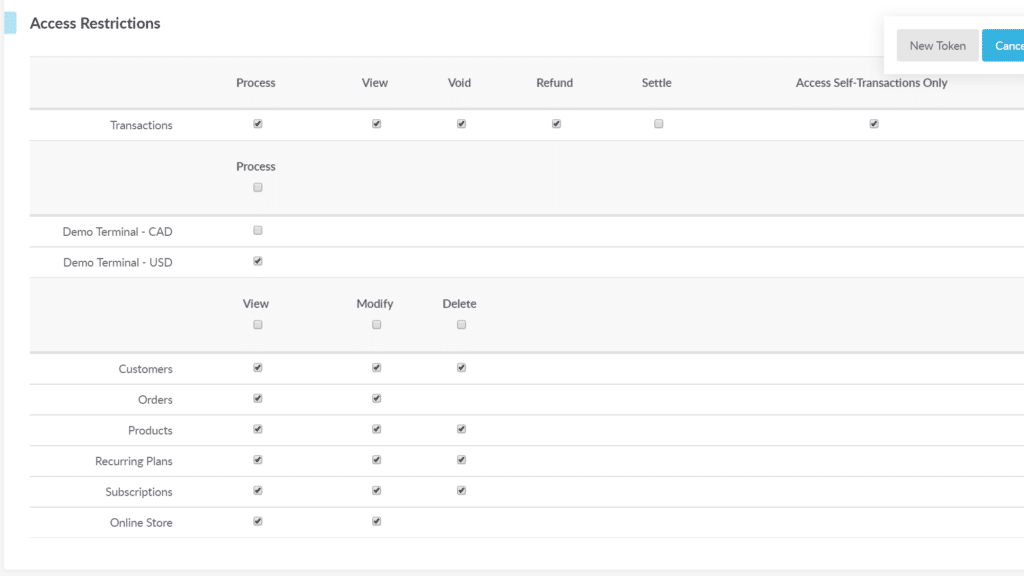
Helcim Virtual Terminal
- Log in to Helcim Virtual Terminal at https://gateway.qa.helcim.com/login/.
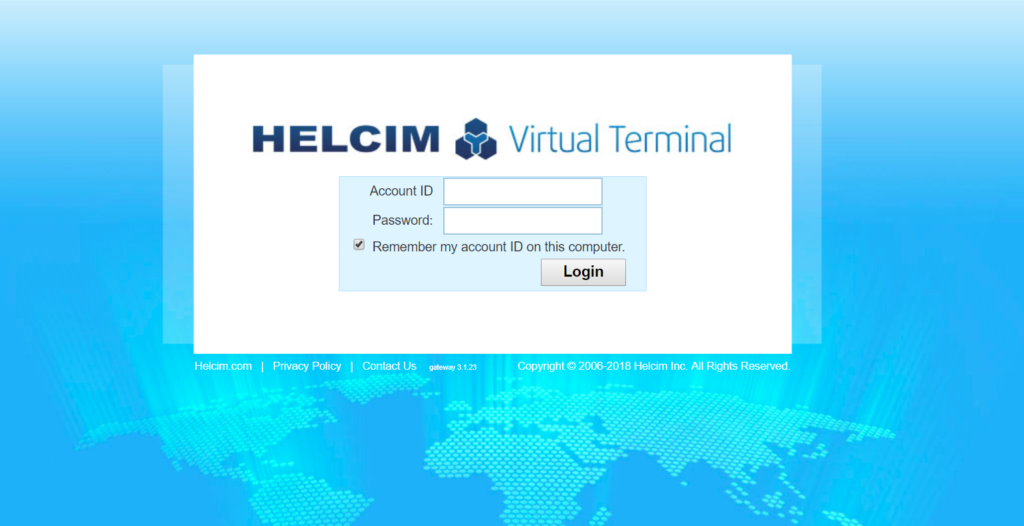
- Once you have logged in, you can find your Account ID in the top right corner of the screen. You can copy and paste this into the AccountID field on the configuration page.
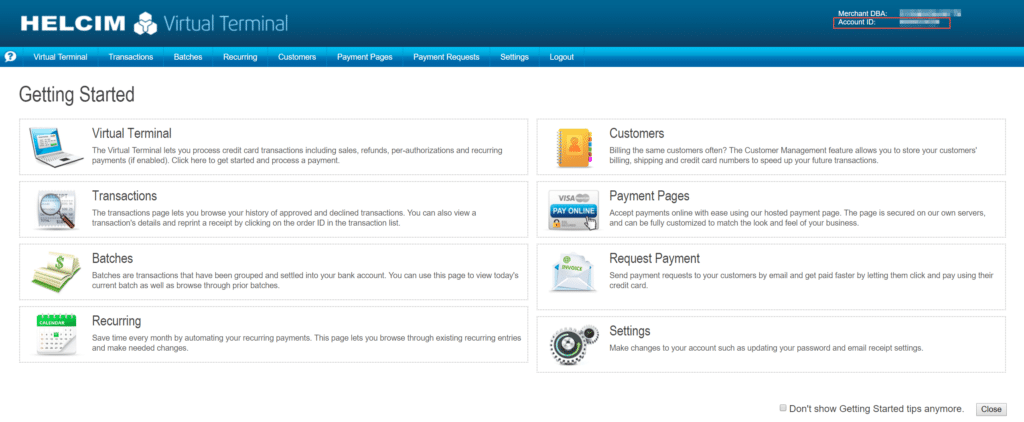
- Click on the “Settings” button. In the Settings section you will find the your Gateway Token area.
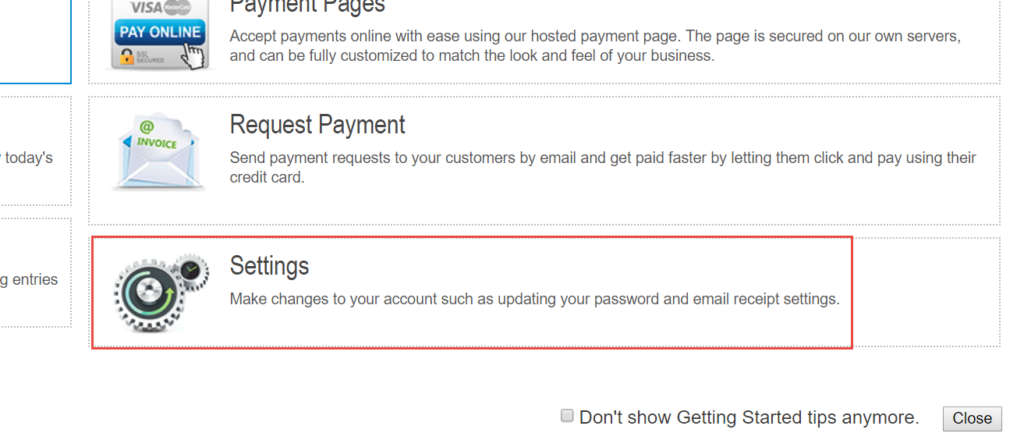
- If you have not yet generated a Gateway Token, you can create one now by clicking on the “Generate a new token” button. Otherwise, copy and paste the Gateway Token into the API/GatewayToken field on the configuration page.

Stripe Configuration
To configure Stripe you will need a Secret Key.
- Log into the Stripe Dashboard at https://dashboard.stripe.com.
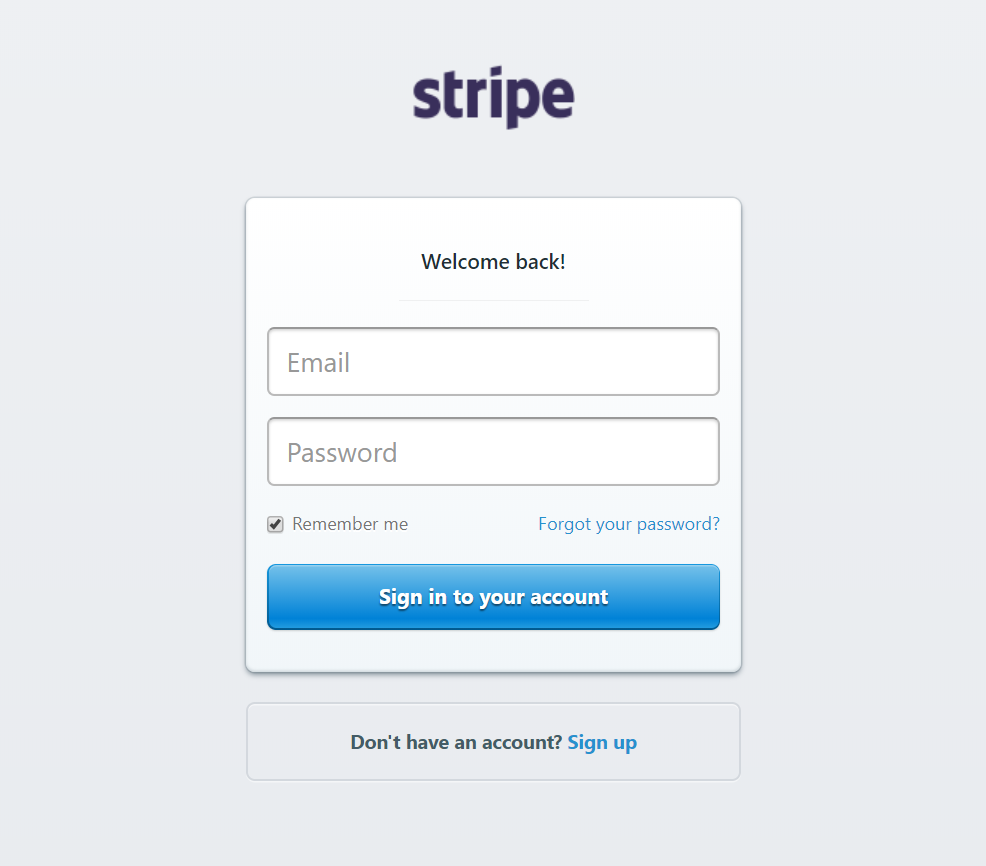
- Once you are looking at the Dashboard, select “Developers” from the side menu to open the Developers menu, and then select “API keys”.
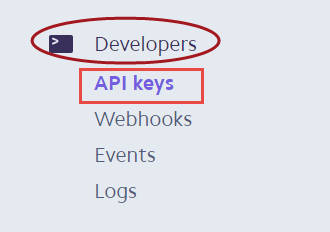
- Several API Keys are shown on the screen. If there is a button next to “Secret key” that says “Reveal live key token” click on it to reveal the Secret key token. You can copy and paste this key into the SecretKey field on the configuration page.

---------------------------------------
Once these values have been successfully saved in the configuration screen, PowerCharge is ready to begin tokenizing credit cards.
European Stripe users
Starting September 14, 2019, banks in Europe will start using a 3D Secure system. This extra security will be applied to some credit card charges. You may find that occasionally a charge will need to undergo an authentication process where the card-holder must agree to a charge before it can be processed.
If using the Stripe gateway, PowerCharge will recognize that this process is taking place, and put the affected transaction into a Pending state. Charges in a Pending state have not yet completed or failed and are waiting on a response from the card-holder.

Credit Card Transactions which are Pending and awaiting authentication will appear in the Pending Transactions view.

To determine whether these charges have been authenticated, a workflow and action have been included that will get the most recent results from Stripe. To run this workflow, select Run Workflow from the Ribbon (it may be under the ellipsis menu), and select Run Workflow.
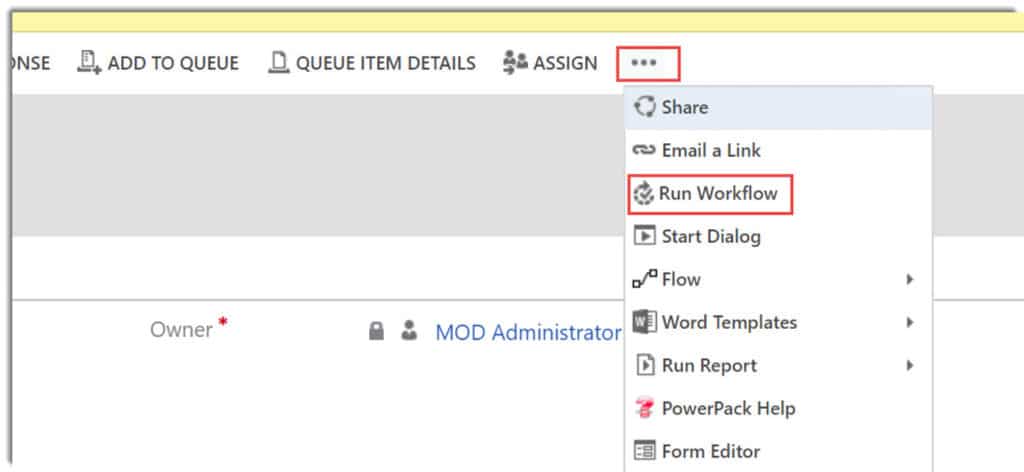
Then select the workflow called Check Transaction is Authenticated, and click Add. This will run the PowerCharge Check Authentication Action on the selected Transaction record, and determine if the charge is successful, failed, or still pending.
*Included is an on-demand workflow that will use an action to check pending charges from a view, or form. This action can be configured as needed by the PowerCharge user. If you need assistance, our billable team can help you set up a timed or scheduled workflow that uses this Action in a way that suits your needs.
Creating a Credit Card Record
Once you’ve imported PowerCharge navigate to the PowerPack section of your CRM and you will see PowerCharge there. To enter a new credit card select Credit Card from the navigation and click on New.

Fill in the credit card information and the billing information on the form. Then choose a Payment Gateway to store the card with. The default gateway will automatically be set based on the default that you have configured in your PowerCharge setup. If you’d like to change your default gateway, you can do so in the PowerCharge setup area, within the PowerCharge configuration. If you would like to relate this credit card to a contact or account, choose a contact or account in the lookups at the top of the credit card record.
If using the Stripe payment gateway, you will be prompted to choose a default currency to charge for the card. This will allow you to choose from more than 135 international currencies.
Warning: Do not remove fields from the credit card or credit card transaction records. These fields are necessary for the plugins related to PowerCharge to function as they should and may also be required by the payment gateway itself. You may add fields to the credit card forms if you would like, but do not remove fields from the form.
Click on Save. You will know the credit card has been successfully saved with your gateway, because an encryption token and a credit card status will be passed back to you with a “SUCCESSFUL” message of some sort. If the card was not saved successfully, you will see “FAILED” and it will tell you why the card has not been saved successfully. As soon as the card is saved with the gateway, the card number will display only the last 4 digits, and the CCV will be wiped.

Note: If your credit card status asks you to check the PowerCharge log, do an advanced find for PowerCharge Log add all columns to the search and click Results.
Updating a Credit Card Record
To update a credit card record you must re-enter the entire credit card number, expiration date, and CCV before the information can be re-submitted to the payment gateway. If all of the information is not updated, the update will be isolated to CRM, which will be noted in the Credit Card Status on the record. This provides security as well as a means to make simple changes to the form such as a telephone number or parent contact without passing the information to the gateway.
Charging/Refunding a Credit Card
There are multiple ways to go about charging the credit card. You can charge a card manually either from the credit card record or from the account or contact record, or you can charge the card automatically through a workflow.
From the Credit Card Record
Navigate to the credit card record you wish to charge and open the record. Click on the “more options” icon, select ‘Other Activities’ and then select ’Credit Card Transaction’.

Fill in the Subject line, set the regarding, select a credit card to charge (if it isn’t already listed there), select whether you want to Charge or Refund the card, enter an amount and click on Save or Mark complete. This will run the transaction (be patent while the transaction runs).
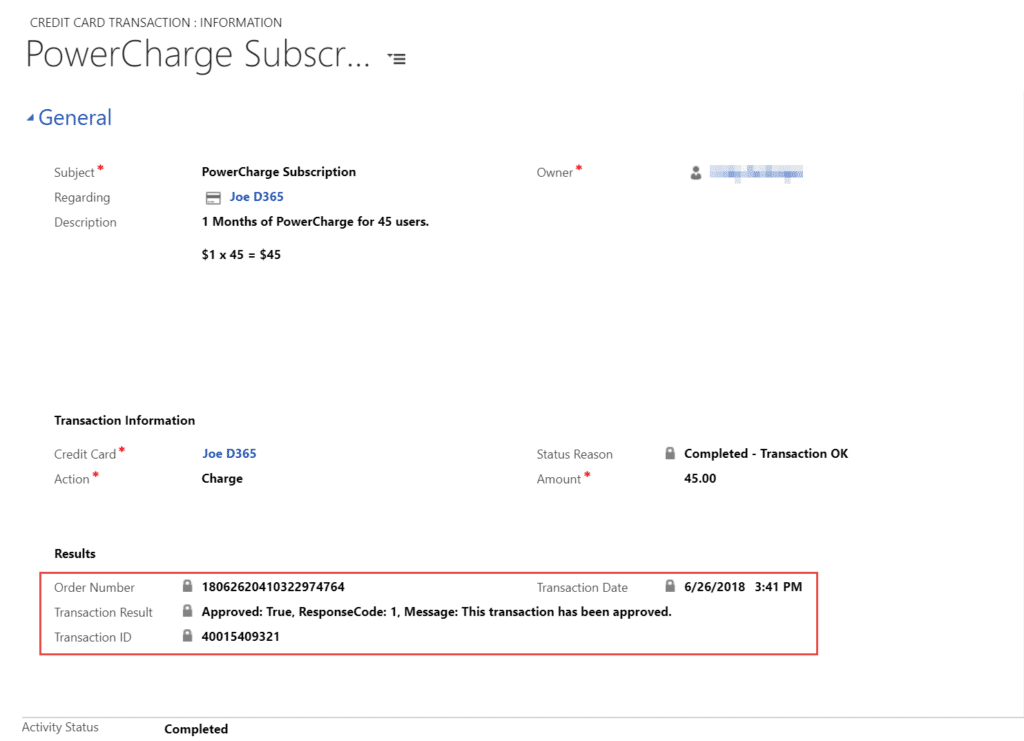

Note: If using the Stripe payment gateway, the transaction will default to the same currency as the currency on the related credit card. The currency can be changed, if desired.
If you need to refund the card, you will need to select an order to refund, and the amount of the refund cannot exceed the amount of the charge. You will know the transaction was successful because a Transaction Result with a message of “APPROVED” and a Transaction ID will get populated back into the activity record.
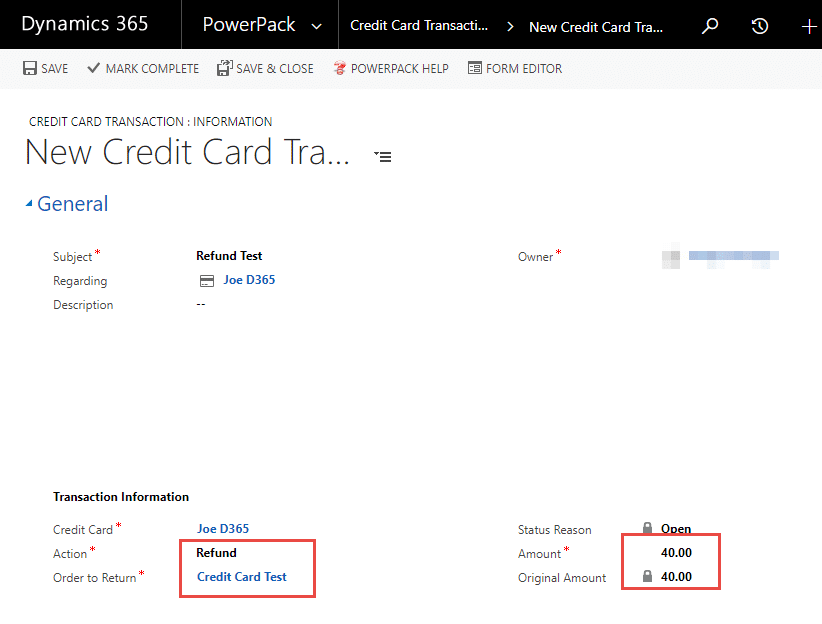
Note: If using the Stripe payment gateway, refunds will always use the same currency in which the original transaction was charged.
From the Contact/Account Record
Navigate to and open a contact or an account record. Select the ellipses, then Other Activities and Credit Card Transaction.
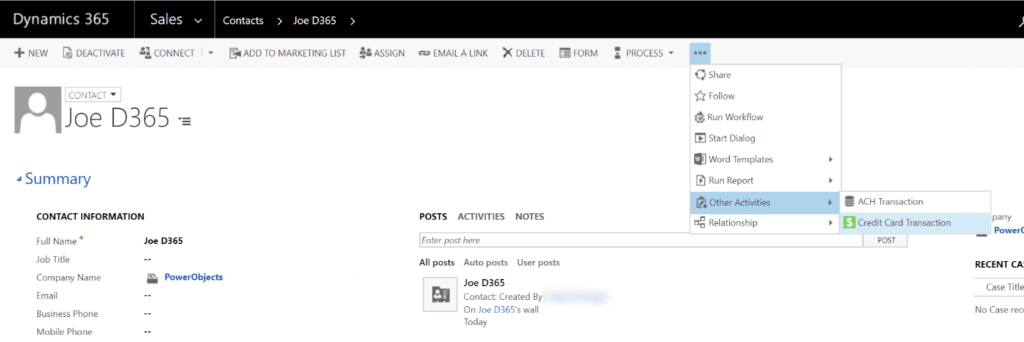
Fill in the Subject line, set the regarding, select a credit card to charge (if it isn’t already listed there), select whether you want to Charge or Refund the card, enter an amount and click on Save or Mark complete. This will run the transaction (be patient while the transaction is running). If you need to refund the card, you will need to select an order to refund, and the amount of the refund cannot exceed the amount of the charge. You will know the transaction was successful because a Transaction Result with a message of “APPROVED” and a Transaction ID will get populated back into the activity record.
With a Workflow
If you are trying to process a monthly subscription or a charge that occurs on a regular basis, you could charge credit cards with a workflow. How you set up the workflow will vary depending on what you are trying to do and can be more complicated depending on your process; please contact your CRM administrator to help you build this workflow.
The credit card transaction will show up under the credit card that was charged, and will also show in the list of closed activities on the record the transaction was set regarding (in the above example, if we go to closed activities on the Joe CRM contact record, we will see the credit card transaction listed there).
Re-run a Credit Card Charge Workflow
When you import PowerCharge, a workflow (deactivated) is automatically imported into your CRM. This workflow allows users to re-run a credit card transaction on demand. To use this workflow, you will first need to activate it. To run the workflow, open the credit card transaction record you’d like to re-run, click on Run Workflow and choose the “Re-run Credit Card Transaction” workflow.

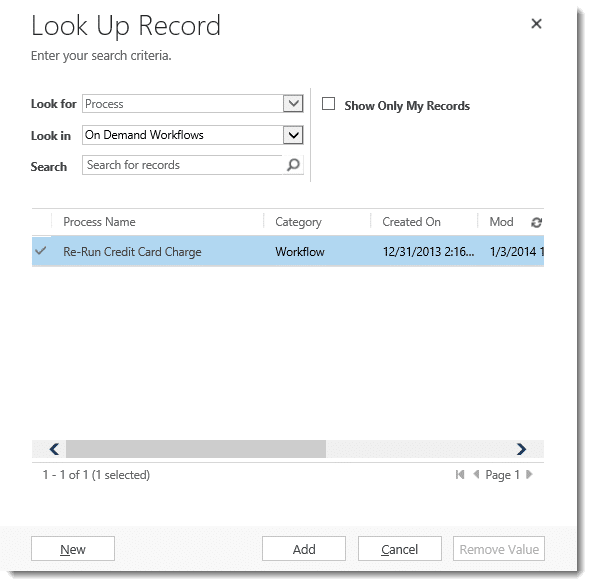
This will rerun the transaction the workflow was initiated from.
Importing Historical Transactions
On the credit card transaction screen, you will notice a check box called “Historical Import” if you expand the Maintenance section.
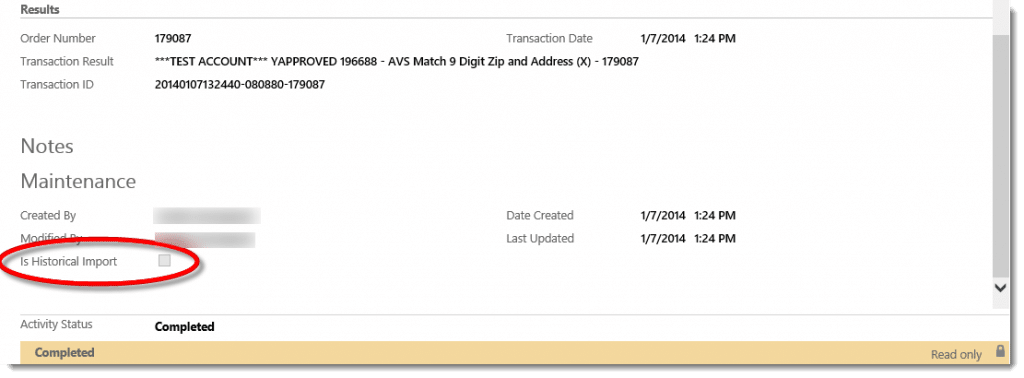
If you want to import historical transaction records, you can use the general import feature of CRM. Remember, if you want to import transactions related to credit cards, you need to import the credit cards first, and then import the transactions related to them. When you’re importing transactions, remember to put the value for this checkbox to “true”/checked in your spreadsheet so that the transactions do not actually get run. If the “Historical Transactions” check box is not checked, the transactions will be run as they normally would and the related card will get charged.
ACH (Automatic Clearing House)
Payments
Note: These payments are only available using the Authorize.net payment gateway.
The ability to process ACH payments allows users to tokenize Savings, Checking, or Business Checking account information with Authorize.Net’s Customer Information Management (CIM) interface for use with future transactions in a safe and secure way.
Minimum Requirements
- You must have a U.S. based merchant bank account that allows internet transactions.
- You must have an e-commerce (Card Not Present) Authorize.Net Payment Gateway account.
- You must have the Customer Information Manager (CIM) interface activated on their Authorize.Net account.
- You must have completed the eCheck.Net application and underwriting process with Authorize.Net and is able to process eCheck.Net transactions.
Documentation on Authorize.Net’s Customer Information Manager and eCheck.Net services can be found in Authorize.Net’s developer center on the Authorize.Net web site. It is highly recommended that PowerCharge users review these documents before engaging in any business activity.
Important Notes
- Net settles credit card and eCheck.Net transactions once every 24 hours as per the merchant’s CIM Transaction Cut-Off Time setting.
- PowerCharge ACH transactions made through Authorize.Net’s eCheck.Net process are not indicative of an instantaneous transfer of funds. It is recommended that the merchant verify that any funds transferred through Authorize.Net’s CIM interface have cleared their merchant bank before rendering services.
- See Processing ACH Transactions with PowerCharge for more details.
- Transactions returned as Non-Sufficient Funds (NSF) may be subject to state mandated returned check fees. For the current fee table, see the following: https://www.achex.com/html/NSF_pop.jsp
Tokenizing a Bank Account
with PowerCharge
Tokenizing a bank account with Authorize.Net’s CIM interface is quick and easy.
Creating an ACH Account Record
First, open Dynamics CRM and Access the PowerPack tab to bring up the PowerCharge-related entities. Select the ACH Accounts entity, and click on New to bring up a new ACH Account form.
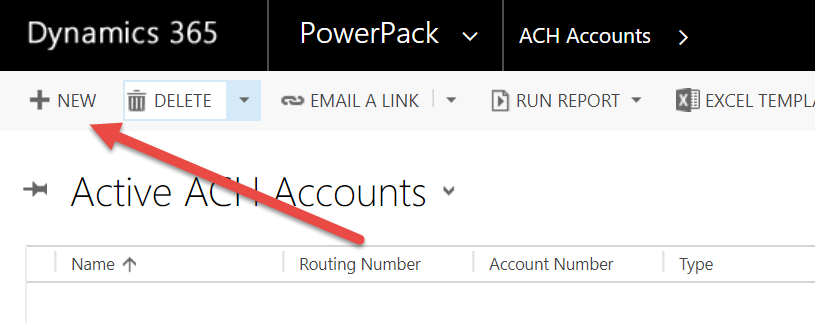
Enter the required fields on the ACH Account form and click the Save.
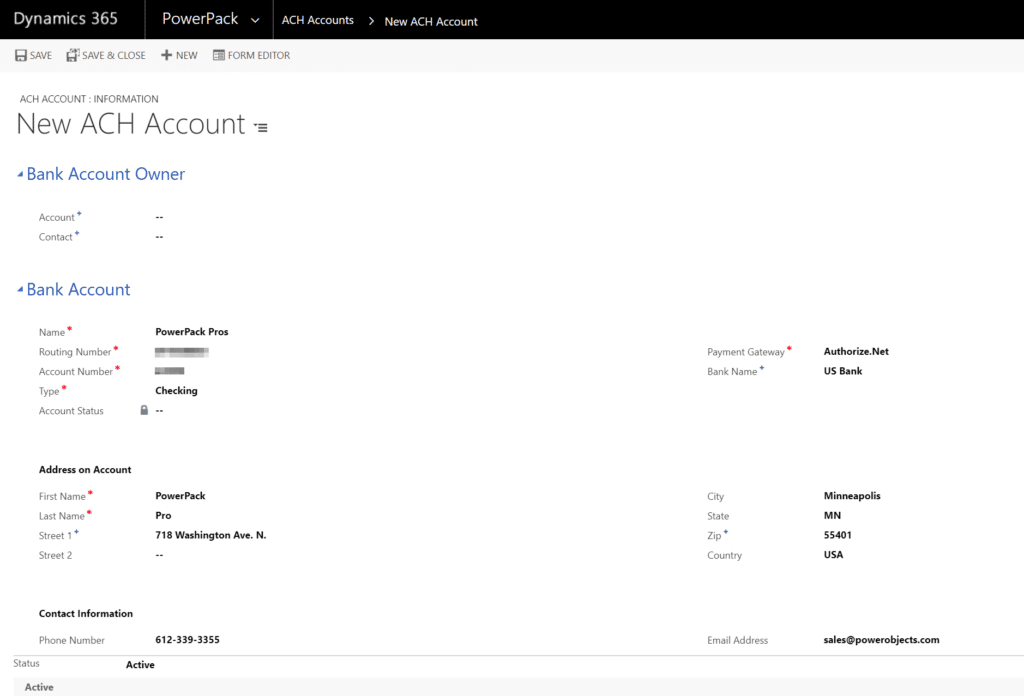

Updating an ACH Account Record
Changes made to the ACH Account record in CRM will only be passed to Authorize.Net’s CIM interface if both the client’s routing number and account number are entered on the form at the time the record is updated. This provides security as well as a means to make simple changes to the form such as a telephone number or parent contact without passing the information to the gateway. The credit card status will reflect whether the update has been isolated in CRM or not.
Deleting an ACH Account Record
Should the need arise to delete an ACH Account record, simply press the Delete button for the record on the CRM Ribbon.
Note: Deleting an ACH Account record in CRM will also delete the associated customer profile in Authorize.Net’s CIM interface. Any ACH Transaction records in CRM will remain in CRM for record keeping purposes, but associated records may not be available for viewing in Authorize.Net’s CIM interface.
Processing ACH Payments
Transactions can be processed against an ACH Account by accessing the ACH Transaction form in CRM. This form can be opened through various CRM Activities menus or through the ACH Account form.
Charges
To create an ACH Transaction, navigate the ACH Account you would like to charge, and click on ACH transactions in the menu.
Click on Add New ACHTransaction to create a new charge or refund.

Specify a subject for the transaction, choose a record to set the transaction regarding, and input a description for the transaction. Then choose whether you are charging or refunding, and specify an amount. Then Save or Mark Complete to run that transaction.

Wait for PowerCharge to communicate with the gateway. When a response returns from the payment gateway the results of the transaction will be displayed on the form, telling you whether the transaction succeeded or failed, and if it failed, why it failed.
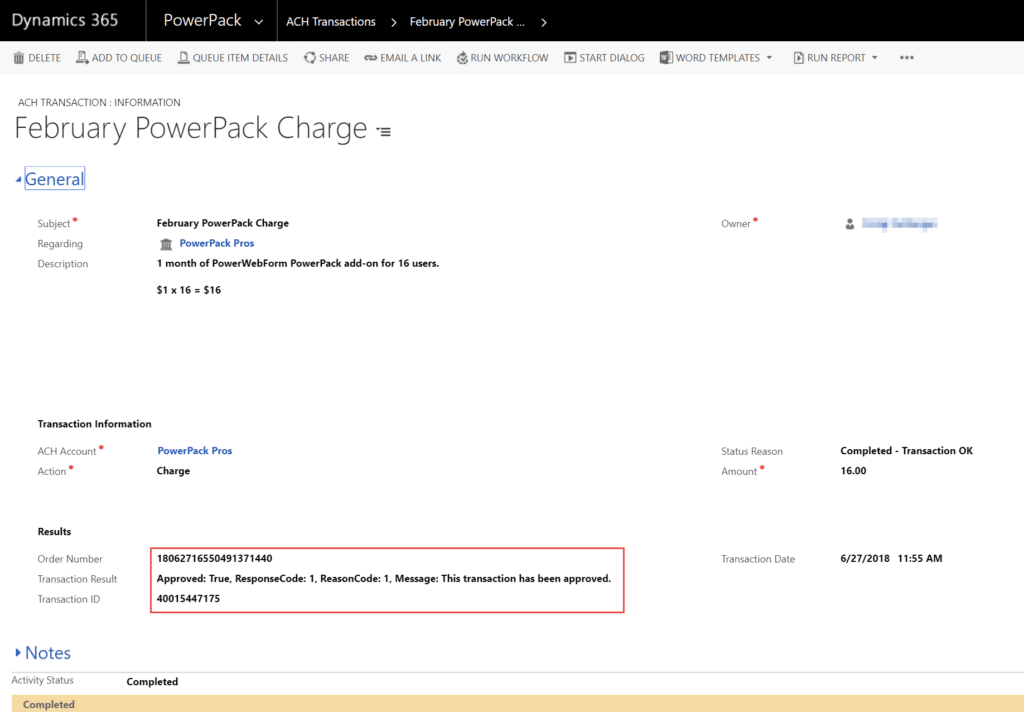
Refunds
Processing a refund is would follow the exact same process as processing a charge. To process a refund, open a new ACH Transaction record and change the Action field from “Charge” to “Refund”. Then select a previously settled transaction in the Order to Return lookup field. Enter an amount, and save.

Please be aware that it is unlikely that the payment gateway will allow a cumulative refund amount greater than the amount of the original purchase.
When a response returns from the payment gateway, the results of the transaction will be displayed on the form in the same manner as ACH Transaction charges.
Important Notes on ACH Transactions
- Net’s eCheck.Net services will not accept transaction requests from client bank accounts that are not located within the United States.
- A successful message on an ACH Transaction only indicates that the request has been accepted for eCheck.Net processing. ACH Transactions still need to go through the settlement process with the client’s bank before funds are transferred to the merchant’s bank account. Be aware that, unlike credit card transactions, the ACH Transaction process can take several days to complete.
- It is recommended that merchants wait until funds have cleared the client bank’s approval processes before rendering any services paid for using PowerCharge or Authorize.Net’s eCheck.Net services.
- Net’s CIM interface settles ACH Transactions once per day. The time of day can be changed through the CIM configuration options. See Authorize.Net’s Customer Information Manager Documentation for instructions on how to change this setting.
- If a transaction is not settled all Refund attempts against it will fail. Example of a failed refund attempt:
Approved: False, ResponseCode: 3, Message: The referenced transaction does not meet the criteria for issuing a credit.
- Net’s sandbox account will never settle ACH Transactions. This means that PowerCharge will never get a successful response on a refund transaction if PowerCharge’s Authorize.Net Mode configuration value is not set to ‘Live’.
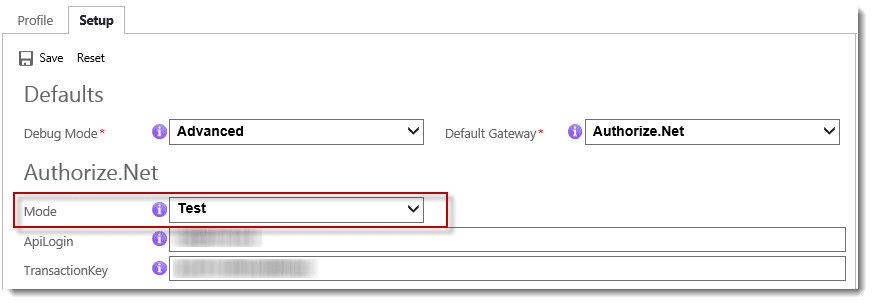
Example of a Refund attempt in ‘Test’ mode:
Approved: False, ResponseCode: 3, Message: The transaction cannot be found.
PowerCharge Log
If any of your error messages are referencing the PowerCharge Log, you can do an advanced find for this log. Look for the PowerCharge log and click on Results. This log will outline, more specifically, what the error you’ve encountered is. Remember to add the columns you’d like to see in the log, before you click Results.

Uninstalling PowerCharge
To uninstall, first delete any credit card records you created have. Then uninstall as usual, by deleting the solution.
Deleting the solution will remove the existing information and activities that have been created (so it will remove existing credit card and credit card transaction records) from CRM, but the information will still exist in the payment gateway
Uninstalling the solution does not unsubscribe the solution. If you're discontinuing use of the add-on, you must first unsubscribe in the solution.
Using PowerCharge in new UCI
PowerEmail is compatible with the Dynamics 365 online UCI. Make sure you have the UCI compatible version downloaded from our website and installed in your CRM.
Once you have PowerEmail installed you can to add it to your sitemap, along with the entities and web resources the solution provides by editing an app and adding the components in your app designer.
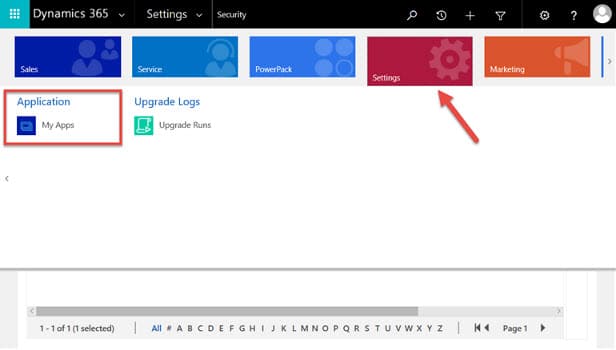


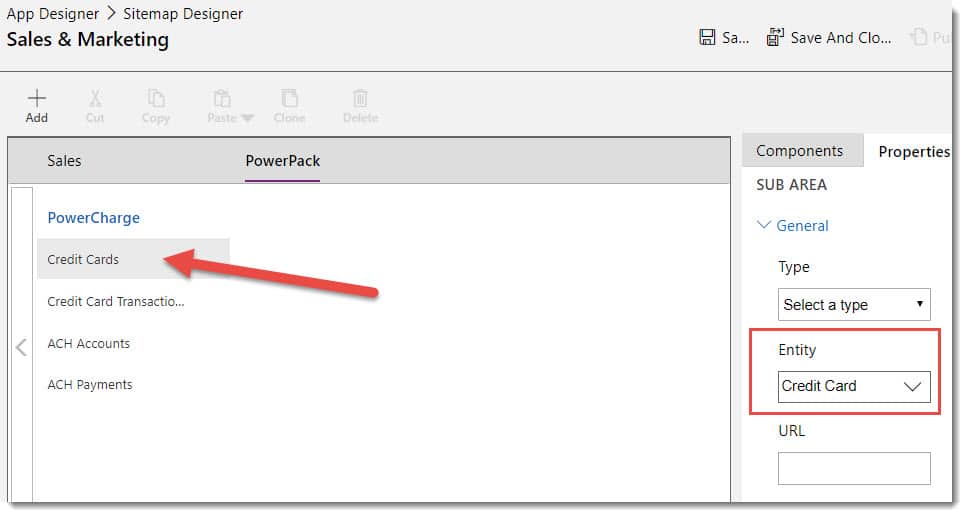
 How Microsoft Power Platform is helping to modernize and enable...
How Microsoft Power Platform is helping to modernize and enable... Deliver an Extraordinary Omnichannel Experience
Deliver an Extraordinary Omnichannel Experience Data Interoperability Key to Improving the Patient Experience
Data Interoperability Key to Improving the Patient Experience
























































